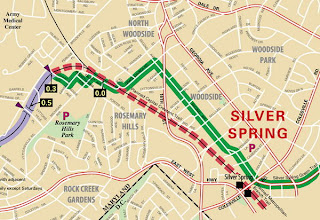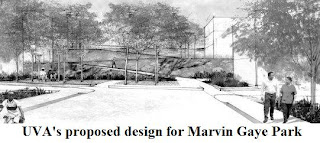
Much like the long-gestating
InterCounty Connector (ICC), the addition of the so-called
Purple Line to the Metro system has enough supporters and detractors to fuel debate far past its proposed 2015 completion. Ideally, the Purple Line would entail a light rail encircling DC - a mass transit alternate to the beltway - though in its current phase the metro addition would link the disparate Red, Green

and Orange lines and run through suburban Maryland, from Bethesda to New Carrollton - a project some supporters say would be of great advantage to low-income commuters.
Curiously, however, it's not the usual developer versus preservationist argument that has led to Purple Line partisanship, but an unusually divided contingent of trail users who can't agree whether the new Metro line will be a godsend or unholy mess for Montgomery County’s
Capital Crescent Trail (CCT) system - an 11 mile long trail running from Georgetown almost to Silver Spring. Final plans for trail and transit have not yet been finalized, and could include either light rail or bus service, a decision yet to be made, but supporters say that a transit line would enable the incomplete trail to finally connect Silver Spring and Bethesda, pay to upgrade the path from dirt to pavement, and provide rights-of-way at intersections now less friendly to bikers.
The debate was initially kicked off by the efforts of
Save the Trail – a local group that’s circulated a petition claiming that the Purple Line would be the only railway in the country to run next to “a popular trail and homes” and, furthermore, that “the existing trail and all of the trees surrounding the trail…would be bulldozed and leveled.” The group claims to have assembled 15,000 signatures for their petition and has suggested alternatives to the expansion – including a new rapid transit bus system and/or an alternative Purple Line route that would run to the
National Institute of Health, instead of Bethesda proper, as is currently proposed.
 Yet the governor-appointed, statewide advisory panel known as the Maryland Bicycle and Pedestrian Advisory Committee MBPAC) has now issued a rejoinder to the claims of negative impact on the trail, and is aligned with groups like the Washington Bicyclists Association (WABA) and Sierra Club in support of the new line. In a meeting yesterday, the 21 members of the MBPAC panel voted unanimously in favor of the project’s current New Carrollton to Bethesda route. “It is clear to us that the Purple Line will benefit the trail by creating grade-separated crossings at many intersections and extending the trail into downtown Silver Spring,” said Eric Gilliland, Executive Director of WABA, in a MBPAC-released statement regarding the matter.
Yet the governor-appointed, statewide advisory panel known as the Maryland Bicycle and Pedestrian Advisory Committee MBPAC) has now issued a rejoinder to the claims of negative impact on the trail, and is aligned with groups like the Washington Bicyclists Association (WABA) and Sierra Club in support of the new line. In a meeting yesterday, the 21 members of the MBPAC panel voted unanimously in favor of the project’s current New Carrollton to Bethesda route. “It is clear to us that the Purple Line will benefit the trail by creating grade-separated crossings at many intersections and extending the trail into downtown Silver Spring,” said Eric Gilliland, Executive Director of WABA, in a MBPAC-released statement regarding the matter.
But Gilliland notes that while WABA - one of the largest trail advocates in the area - is adamant in their support for the project, Save the Trail has otherwise not been involved in any other sort of trail advocacy, and that some property advocates have been against the line from the beginning. "I don't think they represent the interests of the cyclists" says Gilliland, commenting that "the Purple Line would also allow us to complete and upgrade the trail, now dirt, all the way to the Silver Spring transit center."

MBPAC further claims to have “debunked” the theory that the Purple Line will destroy the forested areas surround the trail, in concert with the Montgomery Bicycle Advocates and the CCCT. According to material supplied through links in their e-release, a minimum amount of trees will be lost due to the laying of any track and, even then, new ones will be planted to provide a buffer between track and trail. Furthermore, they argue that up to six times as many people will be using the light rail system as opposed to the trail and, even then, the increased spotlight on the CCT system will allow for expansion not only into Silver Spring, but Rock Creek Park as well.
While the Purple Line concept has already been signed off by Governor Martin O’Malley (who allocated $100 million in state funds for the project) and the Washington Metropolitan Area Transit Authority, and received a favorable environmental impact analysis, Montgomery County is still accepting written comments on the proposal until January 14, 2009. The State of Maryland is expected to announce further details concerning the project’s future in mid-2009.
Montgomery County real estate development news
 In a vote last night, the DC City Council unanimously approved the agreement with development partner PN Hoffman to develop DC's Southwest Waterfront. The Land Disposition Agreement (LDA), signed by both the developer and District back in September, calls for an estimated $1.5 billion redevelopment of the Southwest Waterfront into one of Washington DC's most massive land projects, with 770 residential units, 3 hotels, vast commercial space, and a significant retail venue.
In a vote last night, the DC City Council unanimously approved the agreement with development partner PN Hoffman to develop DC's Southwest Waterfront. The Land Disposition Agreement (LDA), signed by both the developer and District back in September, calls for an estimated $1.5 billion redevelopment of the Southwest Waterfront into one of Washington DC's most massive land projects, with 770 residential units, 3 hotels, vast commercial space, and a significant retail venue.
 In statement released shortly after the passage of the resolution, Hoffman said, “Our collective concern for the success of this project is very real and we are pleased that all sides have come together. We can now focus on the matter at hand – moving this vision forward.” The development team attached to the project is officially comprised of PN Hoffman, Struever Bros., Eccles & Rouse, McCormack Baron Salazar, ER Bacon, Gotham, City Partners, Triden and the recently added Paramount Development. Acresh, another developer initially attached to the project, has since parted ways with the development team.
In statement released shortly after the passage of the resolution, Hoffman said, “Our collective concern for the success of this project is very real and we are pleased that all sides have come together. We can now focus on the matter at hand – moving this vision forward.” The development team attached to the project is officially comprised of PN Hoffman, Struever Bros., Eccles & Rouse, McCormack Baron Salazar, ER Bacon, Gotham, City Partners, Triden and the recently added Paramount Development. Acresh, another developer initially attached to the project, has since parted ways with the development team. 







































.jpg)










